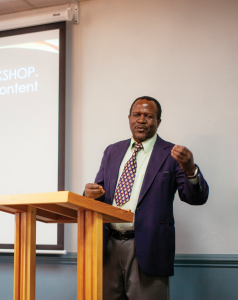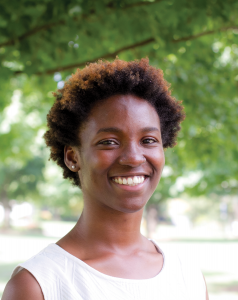
JACQUES MUSHAGASHA MA ‘16
FROM BUKAVU, DEMOCRATIC REPUBLIC OF THE CONGO / LIVING IN HARRISONBURG, VIRGINIA / SERVES AS PRESIDENT OF THE CONGOLESE COMMUNITY ASSOCIATION
 PRACTICUM EXPERIENCE: I introduced restorative justice concepts to the Congolese community, which includes 140 refugees.
PRACTICUM EXPERIENCE: I introduced restorative justice concepts to the Congolese community, which includes 140 refugees.
ACTIVITY: The 27 adults in the workshop learned the difference between restorative justice and penal criminal justice; the principles, values and practices of restorative justice; and how these practices might be used to resolve conflict, repair broken relationships, and strengthen their community. At the end of the training session, they learned how to organize a circle process, the role of the facilitator and the use of a talking piece. Eight young people ages 14-17 also attended as listeners.
WHAT THEY LEARNED: Many participants were very fascinated by the role that a talking piece can have in a conversation. Most of them promised to use the talking piece in their conversation at homes. They also promised, in case of a conflict, to explore restorative justice practices before referring the matter to the legal criminal system. This practicum allowed me to enhance my skills in facilitation and production of curriculum for training or workshops.
A VISION FOR THE FUTURE: I have always dreamed of going back to Congo to work in the area of peacebuilding education and trauma healing. My vision for the Congolese community of Harrisonburg is a community of people well-integrated, both culturally and financially, into the larger Harrisonburg community. I would like to see a community of responsive and productive citizens ready to give back to their native country as well as to the welcoming society.
JODIE GEDDES MA ‘16
FROM THE BRONX, NEW YORK / NOW LIVING IN OAKLAND, CALIFORNIA / EMPLOYED AS A COMMUNITY ORGANIZING COORDINATOR WITH RESTORATIVE JUSTICE FOR OAKLAND YOUTH (RJOY)
 BEFORE THE PRACTICUM: As a first-year student, I was a conflict trainer with the Boys and Girls Club of Harrisonburg. My role was to provide peace education and conflict de-escalation skills. I facilitated small-group discussions and processes for community organizations. Each of these experiences created a larger picture of the Harrisonburg community while connecting me to its residents.
BEFORE THE PRACTICUM: As a first-year student, I was a conflict trainer with the Boys and Girls Club of Harrisonburg. My role was to provide peace education and conflict de-escalation skills. I facilitated small-group discussions and processes for community organizations. Each of these experiences created a larger picture of the Harrisonburg community while connecting me to its residents.
HEADING WEST: As a black woman, I was seeking to be in a place that affirmed my being while engaging with some of the communities most disproportionally affected by systemic harm. Restorative Justice for Oakland Youth provided me with the opportunity to engage in the use of restorative justice as a cultural shift while internalizing these practices for my self-care and healing.
WORKING ALONGSIDE YOUTH: During my practicum, I designed and implemented community organizing training for and with youth. The trainings consisted of political education, journaling and storytelling. I also helped build relationship with community organizations that seek to interrupt the cycles of violence facing black and brown youth/communities.
PERSONAL GROWTH: I recognized the importance of stories and the way narratives inform systems change, especially when speaking with those that do not see the symptoms of oppression. I was challenged by the way forms of oppression became normalized in the telling of some stories. I believe we have all been taught to sit with oppression, as a comfort.
THE FUTURE: I believe I was led to RJOY and I am grateful to be continuing this journey.
AARON ODA MA ‘16
FROM AUBURN, INDIANA / NOW LIVING IN HARRISONBURG, VIRGINIA / EARNING AMEDIATION CERTIFICATE
 TO MYANMAR: I spent my practicum in Yangon, Myanmar (Burma) with People In Need (PIN), an organization committed to working with local communities in solving problems using the creative resources already available. This included many indigenous and creative ways for healing, resilience, storytelling and relationship building in order to transcend the atmosphere of violence. I was primarily interested in working with arts-based peacebuilding methodologies, addressing sectarian and identity-based violence, and studying and analyzing the current conflicts in Rakhine State. I had prior connections to Myanmar, having worked in the past with Burmese refugees in Georgia and Indiana.
TO MYANMAR: I spent my practicum in Yangon, Myanmar (Burma) with People In Need (PIN), an organization committed to working with local communities in solving problems using the creative resources already available. This included many indigenous and creative ways for healing, resilience, storytelling and relationship building in order to transcend the atmosphere of violence. I was primarily interested in working with arts-based peacebuilding methodologies, addressing sectarian and identity-based violence, and studying and analyzing the current conflicts in Rakhine State. I had prior connections to Myanmar, having worked in the past with Burmese refugees in Georgia and Indiana.
DOCUMENTARY FILM: I conducted research into how arts-based peacebuilding approaches are addressing ethno-religious conflict in Myanmar. The case studies – collected with interviews of local participants working in the conflict transformation field, human rights workers, musicians, psychologists, and others – took the shape of a documentary film.
NEW KNOWLEDGE: My practicum provided me with the analytical and relational lens to interact and work alongside people living amidst democratic transition. I learned how to address issues of interfaith identity conflict in creative ways. In a collectivist, indirect culture such as Myanmar, the need for sensitivity and imagination is crucial. I also see clearly the need for local voices and agency within peacebuilding processes and assessments. I often navigated and mediated the different communication and conflict styles between Western folks and local Burmese in the office.
POWER OF THE ARTS: After this experience, I can attest to the power of the creative arts and embodied practice as a medium of conflict transformation. Having had the opportunity to observe participatory theater in Karen State and listen to the countless testimonies of practitioners for the documentary film project, I can proclaim how powerful the opportunity for storytelling, emotional expression, and creative problem-solving is in regard to a holistic understanding of service and empowerment in peacebuilding.
FUTURE PLANS: I am working towards the Virginia General District Court mediation certification. After a year or so in the States, I envision continuing my work overseas in international peacebuilding involving capacity-building and training, arts-based approaches to peacebuilding, and facilitating dialogue and bridges of understanding to diverse groups of stakeholders involving identity-based conflicts. I would love to continue this passion for using documentary film for participatory peacebuilding efforts as well.